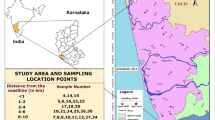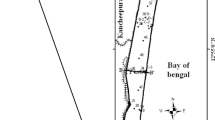Abstract
A majority of saltwater intrusion into freshwater aquifers occurs in coastal regions. The interactions between groundwater, surface water, and estuarine water are complicated and highly dynamic. A decrease in the groundwater level below the mean sea level results in the reversal of the hydraulic gradient thereby causing the seawater to move inland. Seawater intrusion is triggered by the excessive pumping of coastal groundwater and sea-level rise. The inland motion of seawater into the coastal aquifer is an important reason for the deterioration of the coastal groundwater resources. Geochemical criteria like chloride and TDS concentration, chloride/bicarbonate ratio, and isotope studies have been used by researchers across the world to identify the origin, pathways, rates, and current status of salinization in order to properly understand the interplay between transport and chemistry in the seawater-freshwater mixing zones prevalent in coastal aquifers. This study deals with a comprehensive hydrogeologic and geochemical investigation to identify seawater intrusion into a coastal groundwater basin of West Bengal, Eastern India. The major cations (Ca2+, Mg2+, and Na+) and anions (HCO3ˉ, Clˉ, and SO42ˉ) dissolved in the coastal groundwater were analyzed in this study. The relative abundance of major cations and anions was analyzed using Pie and Radial diagrams. Piper and Chadha’s diagrams were used to find the dominant groundwater types and their geochemistry in the study area. USSL diagrams were used to classify groundwater for analyzing its suitability for agricultural uses. In addition, Gibbs and HFE-D diagrams were also analyzed to identify major geochemical processes influencing existing groundwater chemistry. Finally, the seawater mixing index (SMI) was developed to identify the aquifers affected by seawater-freshwater mixing as well as to explore the current status of seawater intrusion in the study area.






















Similar content being viewed by others
Abbreviations
- IDW :
-
Inverse distance weight
- MDTW :
-
Medium deep tube well
- MSL :
-
Mean sea level
- OCC :
-
Odisha Coast Canal
- PHED :
-
Public Health Engineering Department
- SMI :
-
Seawater mixing index
- STW :
-
Shallow tube wells
- SWID :
-
State Water Investigation Directorate
- TDS :
-
Total dissolved solids
- USGS :
-
United States Geological Survey
- USSL :
-
United States Salinity Laboratory
- ArcGIS :
-
Aeronautical Reconnaissance Coverage Geographic Information System
- CBE :
-
Charge-balance error
- CCA :
-
Culturable command area
- CGWB :
-
Central Ground Water Board
- DTW :
-
Deep tube well
- EC :
-
Electrical conductivity
- GoI :
-
Government of India
- GoWB :
-
Government of West Bengal
- HFE-D :
-
Hydrochemical facies evolution diagram
- HTC :
-
Hijli Tidal Canal
References
Abidin HZ, Andreas H, Gumilar I, Sidiq TP, Gamal M, Murdohardono D, et al (2010) Studying land subsidence in Semarang (Indonesia) using geodetic methods. FIG Congress pp 11–16
Allen DM, Suchy M (2001) Geochemical evolution of groundwater on Saturna Island, British Columbia. Can J Earth Sci 38:1059–1080
Balasubramanian M, Sridhar SGD, Ayyamperuma R, Karuppannan S, Gopalakrishnan G, Chakraborty M, Huang X et al (2022) Isotopic signatures, hydrochemical and multivariate statistical analysis of seawater intrusion in the coastal aquifers of Chennai and Tiruvallur District, Tamil Nadu, India. Mar Pollut Bull 174:1–14
Bear J (1999) Conceptual and mathematical modeling. In: Bear J, Cheng AH-D, Sorek S, Quazar D and Herrera I (eds) Seawater intrusion in coastal aquifers — concept, methods, and practices, Chapter 9. Kulwar, Dordrecht, pp 127–161
Behera AK, Chakrapani GJ, Kumar S, Rai N et al (2019) Identification of seawater intrusion signatures through geochemical evolution of groundwater: a case study based on coastal region of the Mahanadi delta, Bay of Bengal, India. Nat Hazards 97:1209–1230
Bhattacharya AK, Basack S (2012) Significance of hydrogeological and hydrochemical analysis in the evaluation of groundwater resources: a case study from the East Coast of India. IOSR j Eng 2(9):61–71
CGWB (2022a) District profile. http://cgwb.gov.in/District_Profile/WestBangal/Purba%20Medinipur.pdf. Accessed 1 July 2022a
CGWB (2022b) http://cgwb.gov.in/GW-Year-Book-State.html Accessed 10 July 2022b
Chadha DK (1999) A proposed new diagram for geochemical classification of natural waters and interpretation of chemical data. Hydrogeol J 7:431–439
Dhakate R, Ratnalu GV, Sankaran S et al (2020) Hydrogeochemical and isotopic study for evaluation of seawater intrusion into shallow coastal aquifers of Udupi District, Karnataka, India. Geochemistry 80(4). https://doi.org/10.1016/j.chemer.2020.125647
Gibbs RJ (1970) Mechanism controlling world water chemistry. Science 170:1088–1090
Giménez-Forcada E (2010) Dynamic of seawater interface using hydrochemical facies evolution diagram. Ground Water 48:212–216
Giménez-Forcada E (2014) Space/time development of seawater intrusion: a study case in Vinaroz coastal plain (Eastern Spain) using HFE-diagram, and spatial distribution of hydrochemical facies. J Hydrol 517:617–627
Giménez-Forcada E (2019) Use of the hydrochemical facies diagram (HFE-D) for the evaluation of salinization by seawater intrusion in the coastal Oropesa Plain: comparative analysis with the coastal Vinaroz Plain, Spain. J Hydro-Environ Res 2:76–84
Giménez-Forcada E, Román FJSS (2014) An excel macro to plot the HFE-diagram to identify sea water intrusion phases. Ground Water 53:819–824
Giménez-Forcada E, Vega-Alegre M, Timón-Sánchez S et al (2017) Characterization of regional cold-hydrothermal inflows enriched in arsenic and associated trace-elements in the southern part of the Duero Basin (Spain), by multivariate statistical analysis. Sci Total Environ 593–594:211–226
Goswami AB (1968) A study of saltwater encroachment in the coastal aquifer at Digha, Midnapore District, West Bengal. India IASH Bull 13(3):77–87
Han D, Kohfahl C, Song X, Xiao G, Yang J et al (2011) Geochemical and isotopic evidence for palaeo-seawater intrusion into the south coast aquifer of Laizhou Bay, China. Appl Geochem 26:863–883
Hem JD (1985) Study and interpretation of the chemical characteristics of natural water. United States Geol Surv Water-Supply Paper 2254:263
Hussein H, Ricka A, Kuchovsky T, El Osta M et al (2017) Groundwater hydrochemistry and origin in the south-eastern part of Wadi El Natrun, Egypt. Arab J Geosci 10:170
Hussien R (2017) Application of density-dependant finite element model for studying seawater intrusion in coastal aquifer of Ras El-Hekma, Northwestern Coast, Egypt. Int J Water Res Environ Eng 9(11):226–242
Ikotun OO, Olafusi OS, Quadri AH, Bolarinwa OA et al (2012) Influence of human activities on the water quality of Ogun River in Nigeria. Civ Environ Res 2(9):36–48
Kamra SK, Lal K, Singh OP, Boonstra J et al (2002) Effect of pumping on temporal changes in groundwater quality. Agric Water Manag 56:169–178
Katz BG, Collins JJ (1998) Evaluation of chemical data from selected sites in the Surface-Water Ambient Monitoring Program (SWAMP) in Florida, U.S Geological Survey, Open-File Report 98–559 p 51
Kennedy GW (2012) Development of a GIS-based approach for the assessment of relative seawater intrusion vulnerability in Nova Scotia, Canada. IAH 2012 Congress
Korrai S, Gangu KK, Rao PVVP, Jonnalagadda SB et al (2021) A study on assessment of vulnerability of seawater intrusion to groundwater in coastal areas of Visakhapatnam, India. Environ Dev Sustain 23:5937–5955
Marfai MA, King L (2007) Monitoring land subsidence in Semarang, Indonesia. J Environ Geol 53:651–659
Mohanty AK, Rao VVSG (2019) Hydrogeochemical, seawater intrusion and oxygen isotope studies on a coastal region in the Puri District of Odisha, India. Catena 172:558–571
Murdohardono D, Tobing TMHL, Sayekti A et al (2008) Over pumping of ground water as one of causes of sea water inundation in Semarang City. International Symposium and workshop on Current Problems in groundwater management and related issues water resources, Indonesian Institute of Sciences, Denpasar
Onodera S, Saito M, Sawano M, Hosono T, Taniguchi M, Shimada J, Umezawa Y, Lubis R, Buapeng S, Delinom R et al (2009) Erratum to “Effects of intensive urbanization on the intrusion of shallow groundwater into deep groundwater: examples from Bangkok and Jakarta.” Sci Total Environ 407:3209–3217
Park S-C, Yun S-T, Chae G-T, Yoo I-S, Shin K-S, Heo C-H, Lee S-K et al (2005) Regional hydrochemical study on salinization of coastal aquifers, western coastal area of South Korea. J Hydrol 313(3–4):182–194
Piper AM (1944) A graphic procedure in geochemical interpretation of water analyses. Trans Am Geophys Union 25:914–923
Radhakrishna I (2014) Groundwater systems analysis of Indian coastal deltas: resource potentials, quality trends, saline-fresh water interrelationships, and management strategies. BS Publications, Hyderabad India, p 572
Raharjo P, Yosi M (2017) The identification of land subsidence by levelling measurement and GPR data at Tanjung Emas Harbour, Semarang. Bull Mar Geol 32(1):41–50
Satheeskumar V, Subramani T, Lakshumanan C, Roy PD, Karunanidhi D et al (2021) Groundwater chemistry and demarcation of seawater intrusion zones in the Thamirabarani delta of south India based on geochemical signatures. Environ Geochem Health 43:757–770
Shivanna K, Navada SV, Nair AR, Rao SM et al (1993) Isotope and geochemical evidence of past seawater salinity in Midnapore groundwater. Proceedings of a symposium on isotope techniques in the study of past and current environmental changes in the hydrosphere and the atmosphere, 19–23 April 1993, Vienna, pp 199–212
Sinclair AJ (1974) Selection of thresholds in geochemical data using probability graphs. J Geochem Explor 3:129–149
Umezawa Y, Hosono T, Onodera S, Siringan F, Buapeng S, Delinom R, Yoshimizu C, Tayasu I, Nagata T, Taniguchi M et al (2009) Erratum to “Sources of nitrate and ammonium contamination in groundwater under developing Asian megacities. Sci Total Environ 407:3219–3231
USGS (2022) Is seawater intrusion affecting groundwater on Lopez Island, Washington? https://pubs.usgs.gov/fs/old.2000/fs-057-00/pdf/fs05700.pdf. Accessed 9 July 2022
USSL (1954) Diagnosis and improvement of saline and alkaline soils. Handbook No. 60, US Department of Agriculture, p 160
Author information
Authors and Affiliations
Corresponding author
Ethics declarations
Conflict of interest
The authors declare no competing interests.
Additional information
Responsible Editor: Broder J. Merkel
Rights and permissions
Springer Nature or its licensor (e.g. a society or other partner) holds exclusive rights to this article under a publishing agreement with the author(s) or other rightsholder(s); author self-archiving of the accepted manuscript version of this article is solely governed by the terms of such publishing agreement and applicable law.
About this article
Cite this article
Halder, S., Jha, M.K. Hydrogeologic and geochemical investigations in a coastal basin of West Bengal. Arab J Geosci 16, 420 (2023). https://doi.org/10.1007/s12517-023-11494-y
Received:
Accepted:
Published:
DOI: https://doi.org/10.1007/s12517-023-11494-y




